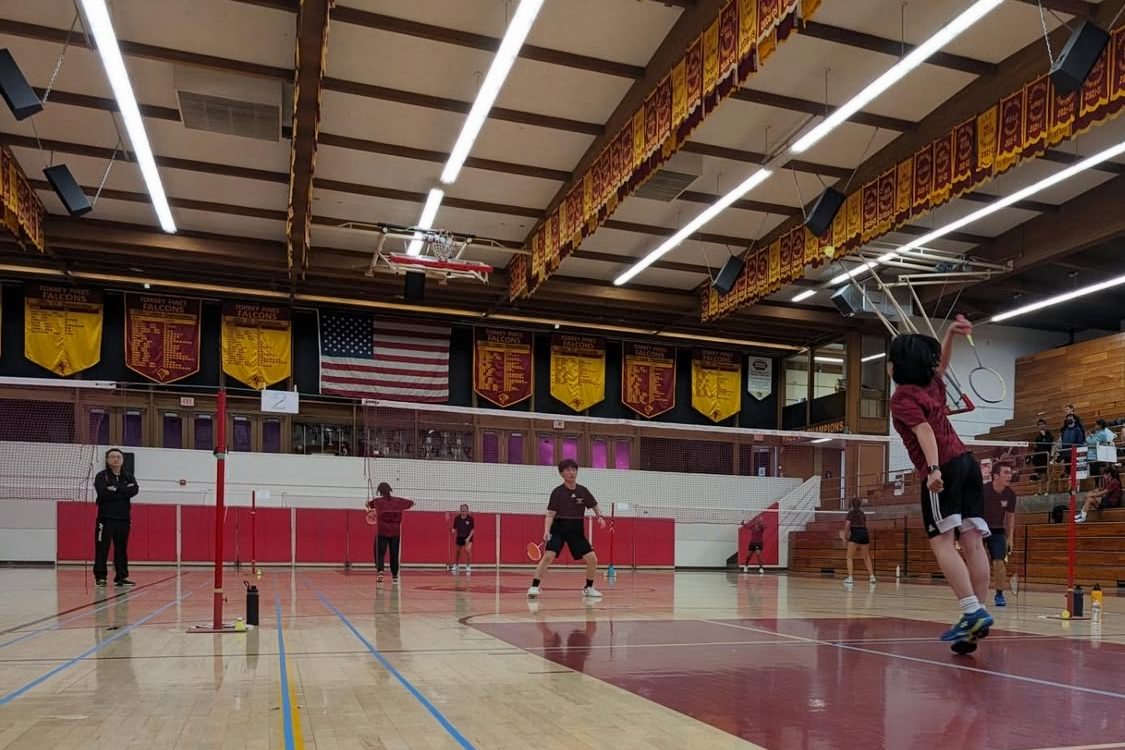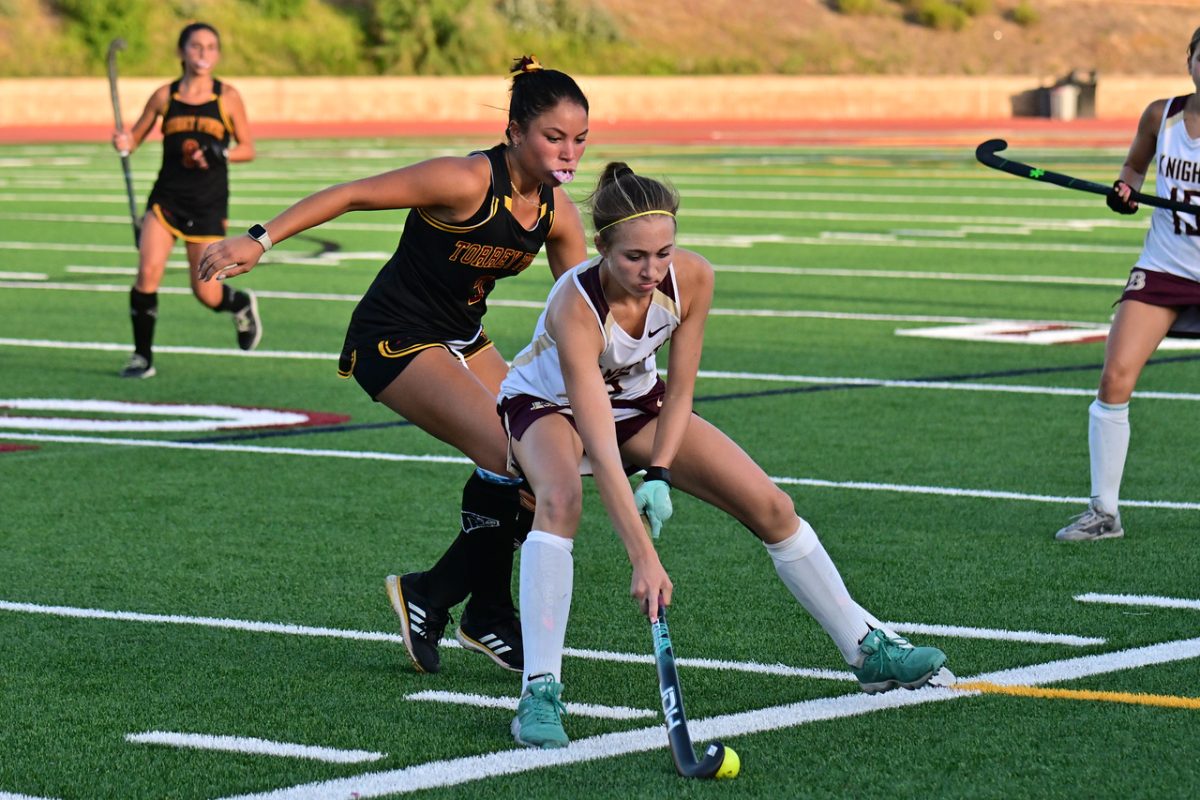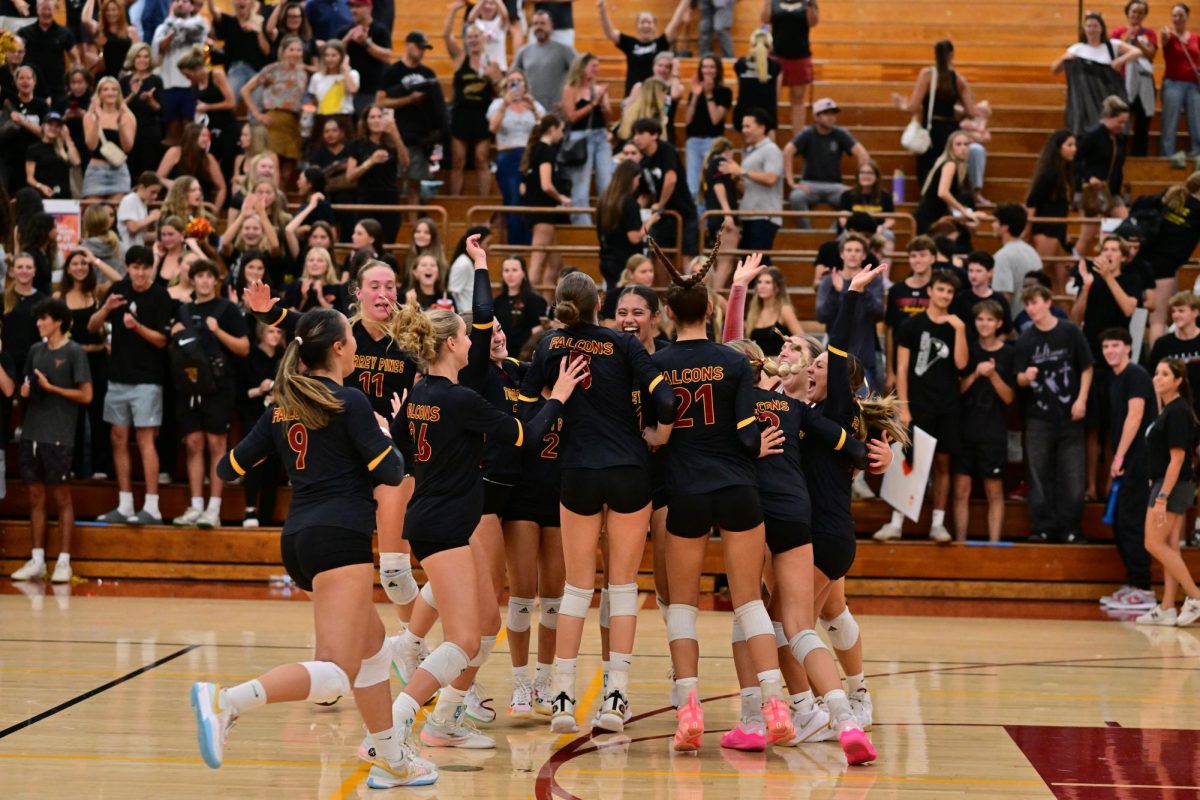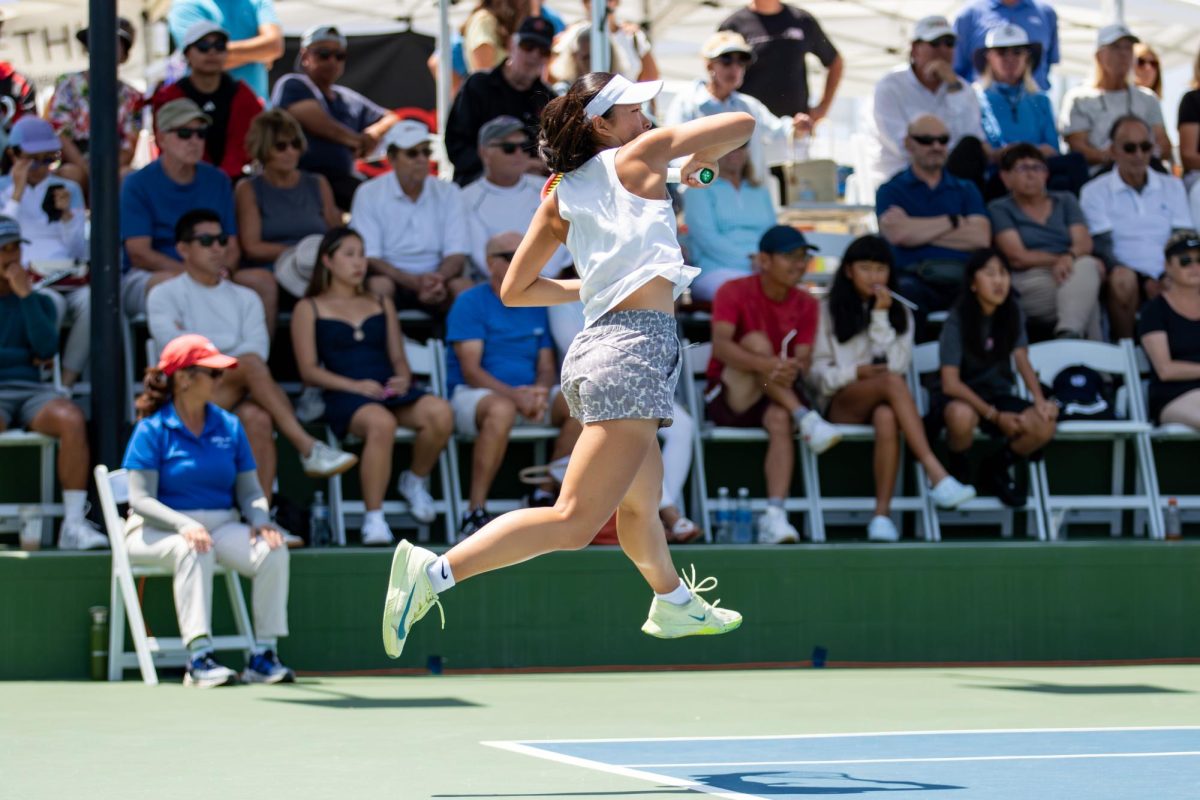It was just another Tuesday badminton practice. Six courts were outlined with blue Scotch tape on the gym floor, each a bit worn out from players darting between the corners. Rackets extended, wrists flicked and shuttlecocks swept over nets. Badminton player Benjamin Goldberg (10) was mid-game, walking backwards on one of the taped-on badminton courts, when he suddenly lost balance over a worn-out Scotch tape.
“I sprained my ankle,” Goldberg said. “I was out for, like, a solid two weeks … I don’t exactly know how, because I would think that’s like the smallest piece of tape, but people still trip on it. People travel a lot. Every day, multiple people trip.”
When asked how this happened, Goldberg had thought “the exact same thing.”
The school’s badminton team has been expressing a need for permanent court lines in the gym since the program began in 2015, but more recently, members have become more active in pushing for these boundaries, including reaching out to Associated Student Body officers and the Athletic Director.
While it is true that badminton is a sport, and like almost all other sports, playing badminton will inevitably risk injury, the fact remains that the school’s student athletes trip every day.
“When you’re walking backwards, I think just even the smallest bit that’s above [can trip someone] … even when it’s flat on the ground,” Goldberg said. “I don’t exactly know how, because I would think that’s like the smallest piece of tape, but people still trip on it.”
While this was the first time Goldberg sustained an injury from the taped court lines, he has tripped over them multiple times before.
“I know three [people that have been injured], but there’s definitely times that I don’t know of,” Goldberg said.
Besides injuries, the use of tape on the gym floors comes at the cost of both money and environmental sacrifices.
The badminton team uses ScotchBlue 1.88 In. x 60 Yds. Painter’s Tape to outline courts. Since the badminton team needs six courts to support the 42 players, and each court uses 105 yards of tape every game — as per the Olympic dimensions — then each game requires 630 yards of tape. This amounts to at least $61 per game, and $427 in total, accounting for all home games in a season. However, during practices, the team omits the innermost lines, totaling the tape yardage to 85.2 yards per court, or 511.2 yards for six practice courts; this sums to a little over $500 per season in practices.
While it is difficult to calculate the exact cost and tape used, as everyone on the team grabs from “whole bucket full of tape” — according to varsity team captain Ethan Jin (12) — and works together to outline courts, it is reasonable to estimate that each season uses upwards of $927 worth of ScotchBlue, or 157 rolls of tape.
“Another problem is that [tape] creates waste,” Chloe Hu (9) said. “I believe it’s our school’s effort to reduce the amount of waste, and by using tape, we’re contradicting this.”
Nevertheless, the badminton team is not the only group who feels the inefficiency of the taped lines. Boys volleyball, a spring sport that uses the gym alongside badminton, have felt the practice negatively affects their agendas.
“I know that a lot of them have a straight, very negative emotion to it,” Goldberg said. “I think once we accidentally left our tape on, and we were told by volleyball [that it] … took them like an hour to take it off and it postponed their game,” Goldberg said.
The badminton and volleyball teams’ practices tend to occur before or after one another.
“The problem with the badminton lines is the fact that [even though] I get that they’re in a problematic situation with not having [permanent lines], it ends up being our responsibility to clean it up as the volleyball team, and it often just causes delays when we start our matches, especially [for] JV,” Griffin Dieter (10), a member of the boys volleyball team, said.
The volleyball team would likely be supportive if the gym were to add permanent badminton court lines, according to Dieter.
“I mean, obviously, the more lines you have, there’s gonna be more confusion with what court’s what,” Dieter said. “But I still do think having permanent lines would just be more beneficial, even if they’re like, faint, I would think.”
The boys volleyball team has expressed their concerns about the tapes to the Athletic Director in the past.
“I just know that we’ve told her about it being a problem before, especially last year during CIFs we had it being an issue,” Dieter said. “I’m pretty sure we just ignored it most of the year, but then during CIFs, you want to look presentable as a school, as well as the fact that it’s a CIF match, and [without the tapes] it looks nicer, and it’s less of a hazard. So that’s when we really started cleaning it up, and we’ve just cleaned it up ever since.”
The taped courts have not only been a hassle for the badminton athletes, but an inconvenience to volleyball as well.
“It’s pretty fragile, and it’s long,” Dieter said. “This is a tape. So if you try to do it and then it breaks, it’s annoying [and] you have to pick it up again, and then there’s always remnants of some adhesion … it’s probably ruining the court as well.”
“The way I understand is that there aren’t any plans, because it requires complete resurfacing of all of the woods,” Principal Rob Coppo said. “Basically all the wood has to be replaced, which took us 25 years to get it replaced the first time. How long it’ll take us to do it a second time is anybody’s bet. It’ll likely be some other principal’s responsibility. I think it’ll be after my time.”
The district will be allocating the funds should such a project be approved.
“Usually you’re in a cycle,” Coppo said. “So, every 10 to 15 years, depending on what the life cycle of the floor is, wear and tear and all that, they put you in a rotation. Then it’s part of normal district maintenance.”
Once a plan is approved, the district will go through a design phase conducted by the maintenance and operations crew. The calculated funds will be matched with the planned budget, leading them into actual construction.
The gym currently has painted squares to indicate where the badminton lines should be taped. The project involving this took about a year of planning and was completed over the summer, according to Coppo.
“Typically every year, I submit what’s called a capital facilities improvement request, and then that goes to maintenance and operations through our district office, and there’s a team of people who look at that, and then they take it under advisement, and they see what they can work out,” Coppo said.
What the district must determine: priority. The badminton situation is somewhat similar to the construction of the school’s long-awaited pool that just opened earlier this school year, according to Coppo.
“I mean, the entire time I’ve been here (16 years), the pool has been a question mark,” Coppo said. “ … When the district looks at what its priorities are … they’re in triage mode … So they start looking at, ‘what is our crew,’ ‘what are our priorities?’ And then it all depends on how the school board decides. They’ve set the priorities with the superintendent. So the pool ended up finally moving to the top of the priority list.”
The badminton team has offered to pay for the project out-of-pocket, according to Hu; yet, the resurfacing is something that must be funded and directed through the district.
“I think badminton thinks they could pay for it,” Coppo said. “I don’t think they know what that real cost is, because I’m telling you it requires taking up the entire existing floor. So that would mean the district would have to decide that the money they spent to do it recently, they’d be doing again. So that would put us ahead of other maintenance projects at other sites. So priority-wise, right now, changing our floors is probably close to the bottom compared to other sites.”
The team ended their 2024-25 season this month, but the possibility of permanent lines remains uncertain. While Jin thinks the team does “not have enough support,” which can partly be attributable to badminton being relatively outside the mainstream in American sports, he believes the lines are a “basic core necessity” nonetheless.
“I really do think that something like lines is pretty simple in terms of accommodation, because this is a basic core necessity,” Jin said. “Like, we can’t play without having tape or at least some indicator of where the court positions are. And, the reason I don’t think it’s a really unreasonable request in particular is because I’ve been to schools like Canyon Hills, Mira Mesa, Patrick Henry, Canyon Crest Academy, [and] all those gyms have lines. And, although you could put a point that those schools have a pretty decent badminton culture as well, I feel like our team here is big enough to the point where we can compete with them.”
The program’s founder won the CIF State Championships in 2015, according to Jin. Current members have placed or won in multiple tournaments as well as received honorable mentions.
“… So, the program, I feel like, does have enough achievements to the point where we should have these basic accommodations and [not have to be] wasting time on tape, and also in terms of our commitment to the school’s sustainability efforts as well, I feel like you can’t really justify wasting tape unless your excuse is like, ‘Oh, we just don’t care about the badminton program,’” Jin said. “I’m not saying that we need ridiculous funding, like a jumbotron, or like the posters of seniors made every year like they do for basketball. But to have lines [is] such a basic accommodation; I feel like that’s pretty reasonable for us.”











